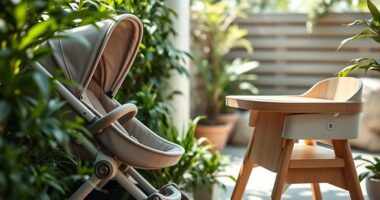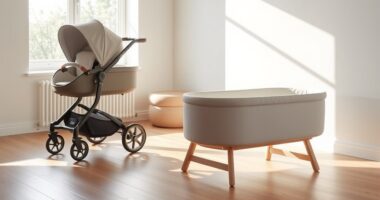When shifting your child to sippy cups, start by choosing a type that matches their developmental stage, like soft spouts for beginners or hard spouts for those ready to progress. Opt for eco-friendly, spill-proof options with handles to encourage independence. Gradually introduce less restrictive lids to help them practice open cup skills. Patience and positive reinforcement are key. Keep exploring different types and tips to support a smooth changeover and foster your child’s growth and environmental awareness.
Key Takeaways
- Introduce sippy cups gradually, starting with spill-proof, soft spouts to build confidence.
- Match cup type (soft or hard spout) to your child’s developmental stage and motor skills.
- Transition to cups with less restrictive lids to encourage open cup drinking over time.
- Use positive reinforcement and patience to ease your child through the change.
- Prioritize eco-friendly, durable cups to foster environmental awareness alongside developmental progress.

Switching your child to a sippy cup is an important milestone that promotes independence and helps develop their drinking skills. It’s a moment that signals growth, but it also comes with considerations beyond just convenience. One key aspect is the environmental impact. Traditional disposable bottles and cups contribute to plastic waste, which can take hundreds of years to decompose and pollute our planet. Choosing reusable sippy cups made from eco-friendly materials can considerably reduce your child’s carbon footprint. Opting for durable, BPA-free, and recyclable options not only supports sustainable practices but also teaches your child early on about caring for the environment. This small step can foster environmentally conscious habits that last a lifetime.
As your child reaches developmental milestones, their ability to handle a sippy cup improves. Around the age of 6 to 9 months, they start to develop the motor skills necessary to grasp and hold objects, making it the right time to introduce a sippy cup. This progression supports their hand-eye coordination and fine motor development. You’ll notice their improved ability to control the flow of liquids, which encourages self-feeding and boosts confidence. When selecting a sippy cup, consider those with handles, textured grips, and easy-to-open lids that match their current skill level. As they practice, they gain independence in managing their hydration without constant assistance, which is a vital step toward more advanced feeding and drinking routines.
Introducing a sippy cup at 6-9 months supports motor skills and independence.
It’s also worth noting that the type of sippy cup you choose can influence your child’s developmental progress. For example, cups with soft spouts are gentle on sensitive gums, while those with harder spouts can help prepare them for regular cups later on. Some cups come with valves that control flow or prevent spills, making the transition smoother and less messy. As your child becomes more adept, you can gradually introduce cups with less restrictive lids to encourage drinking from open cups, further supporting their developmental milestones. This staged approach helps prevent frustration and promotes positive associations with drinking independently.
Finally, keep in mind that the transition to a sippy cup isn’t just about the physical act of drinking; it’s about fostering independence, environmental awareness, and developmental growth. Your patience and choices play an essential role in supporting these changes. By choosing eco-friendly cups that match their evolving skills, you’re not only helping your child develop healthy habits but also contributing to a healthier planet. Reusable sippy cups made from sustainable materials are an excellent choice in this regard. Remember, this transition is a process—celebrate small victories along the way, and your child will gradually become more confident and self-sufficient in their drinking habits.
Frequently Asked Questions
When Should I Introduce a Sippy Cup to My Child?
You should introduce a sippy cup when your child shows signs of teething discomfort or starts thumb sucking habits, usually around 6 months. Offering a sippy cup can help ease teething pain and reduce thumb sucking. Wait until your child can sit up steadily and show interest in drinking independently. This way, they’ll be more comfortable and motivated to use the sippy cup, making the shift smoother.
How Do I Prevent Leaks and Spills With a Sippy Cup?
To prevent leaks and spills with a sippy cup, choose one with a lid design that fits snugly and features spill-proof technology. Make sure the valve is properly sealed and inspect it regularly for wear. Encourage your child to use the cup correctly, and avoid overfilling. Regularly clean the lid and valve to prevent clogging. These steps help minimize messes and keep your child’s drink secure.
Are There Specific Sippy Cup Materials Safe for My Baby?
You should choose sippy cups made from BPA-free plastics or stainless steel options to guarantee safety for your baby. BPA-free plastics are free from harmful chemicals, making them a healthier choice. Stainless steel cups are durable, non-toxic, and resistant to bacteria. Always check labels for safety certifications, and avoid cups with small parts that could pose choking hazards. Your baby’s health depends on the materials you select.
How Can I Encourage My Child to Use a Sippy Cup Independently?
To encourage your child’s independent drinking, offer a variety of appealing sippy cups and let them choose one they like. Demonstrate how to use it, and stay patient as they practice. Praise their efforts and celebrate small successes to boost confidence. Keep the experience fun and relaxed, and avoid pressure. Consistent practice and positive reinforcement will help your child develop independence with their sippy cup over time.
What Common Challenges Might I Face During the Transition?
You might face bedtime resistance and teething frustrations during the shift, but don’t fret—your little one’s just testing your patience, not your love. They may refuse the sippy cup, push it away, or become fussy. Teething pain can make them clingy and cranky, complicating the switch. Stay patient, offer comfort, and remember: every teething tantrum is just a sign they’re growing up—slowly, but surely.
Conclusion
Think of shifting to a sippy cup like planting a tiny seed. At first, it might seem small or tricky, but with patience and the right tools, it will grow into a confident, independent drinker. Just as a seed needs nurturing, your child needs gentle guidance. Before you know it, they’ll be watering their own independence, one sip at a time. Embrace the journey—each small step leads to a big, beautiful bloom.








